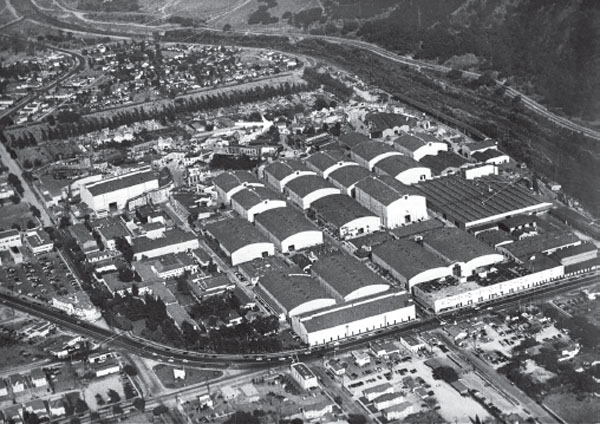
The back lot of Warner Bros. in the late 1930s. The arrow shows the location of Dr. David Burbank’s ranch house. Burbank Historical Society .
3
THE MEDIA CAPITAL
OF THE WORLD
Burbank is sometimes called the “Media Capital of the World,” and this is no idle claim. It is, in fact, one of the major American cities in the worldwide entertainment industry. Burbank hosts many media and entertainment companies, and the Walt Disney Studios, Warner Bros. Entertainment, Nickelodeon, DC Comics and the Cartoon Network are all headquartered in town. Many smaller film production labs, audio studios and technical firms also call Burbank home.
FIRST NATIONAL PICTURES
The Burbank Community Book of 1944 records the day Burbank was about to become a media capital:
One day, according to Howard Martin, who with his parents, Mr. and Mrs. S.A. Martin, owned and occupied the old David Burbank homestead near where Olive Avenue crosses the Los Angeles River and enters Dark Canyon, they saw a wagon unloading a load of lumber on the property of August Handorf, their adjoining neighbor. This was the first inkling the Martins had that they were to have a moving picture studio in the neighborhood. It was likewise the first inkling that the citizens of Burbank had that their city was to be the new home of the First National Studios .
With the exception of A Quiet Day in Burbank , a lost eleven-plus-minute short shown in an unlocated Rose Theater, 14 Burbank’s entry into the world of motion pictures by a major studio began on paper in 1924, when the Associated First National Pictures Company expanded from only distributing films to producing them. In 1924 the company changed its corporate name to First National Pictures, Inc., and in 1926 it built a sixty-two-acre studio lot in Burbank on the Handorf property alongside Olive Avenue, where alfalfa and onion fields thrived. Most of the soundstages are still there.
The only First National film you are likely to recognize by name is an important one. Indeed, it is one of the greatest films of the silent era: Charlie Chaplin’s The Kid , produced in 1921. You might be forgiven for assuming that because it was a First National film and because First National was located in Burbank this important movie was filmed there. It wasn’t—it was filmed in Los Angeles and Pasadena, California.
After purchase by Warner Bros. in 1928, The Dawn Patrol (1930) and Little Caesar (1931) were First National’s most famous films. Little Caesar was filmed in Burbank.
WARNER BROS .
Warner Bros. Studios has been an undeniable presence in town since it merged with First National. Who hasn’t driven down Olive Avenue to Barham Boulevard, heading to Hollywood, and seen those enormous promotional signs hanging on the sides of the soundstage buildings? 15
Angels with Dirty Faces , a Warner Bros. gangster/social issues film from 1938, opens with a splendid sequence showing a New York City street. A man’s newspaper is opened, and in large font, we can see that Harding has been nominated—it’s mid-June 1920. The camera moves along as we see, incredibly, laundry flapping in the breeze from nearly every open tenement window; fruit trucks move slowly up and down a crowded street. The camera moves down, and a street sign becomes visible: it’s Dock Street. Fittingly, a barroom piano is heard playing something that sounds like “The Sidewalks of New York.” An organ grinder is shown; two girls dance on the sidewalk to the music he makes. The camera moves up onto a fire escape balcony, and two boys are shown: one is clearly intended to be the young James Cagney. 16 The dialogue begins. It’s all vivid, visually rich and evocative of old New York. But it’s not New York City at all. The set dressers and production people have fooled you. It’s the Warner’s back lot in Burbank, California! What you’ve just seen represents the artistic height of the old studio system, when infinite care was taken with the smallest details.

The back lot of Warner Bros. in the late 1930s. The arrow shows the location of Dr. David Burbank’s ranch house. Burbank Historical Society .
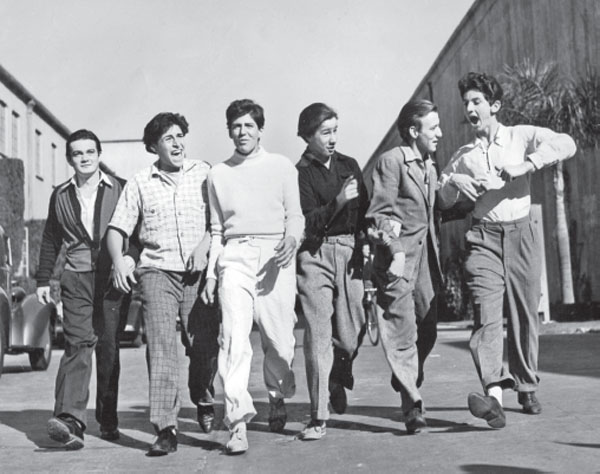
The Dead End Kids, called in this photograph the Plagues of Burbank, stride with mischief in mind on the Warner lot while filming Angels with Dirty Faces in 1938. Left to right: Leo Gorcey, Bernard Punsley, Billy Halop, Bobby Jordan, Huntz Hall and Gabriel Dell. Collection of Michael B. McDaniel .
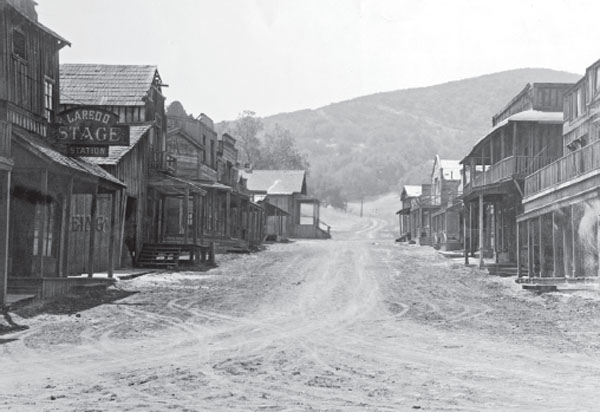
The western set on the Warner Bros. back lot in the 1920s. Three miles behind them thar hills is Hollywood! Burbank Historical Society .
Everyone loves Casablanca (1942), the quintessential Bogie flick. That famous farewell scene on the airport tarmac is iconic. But that was no airport, and that was no tarmac. That was a Warner’s soundstage. In Burbank. And if you ever watched a Warner’s production that included jungle scenes, you probably saw the area that Burbanker Richard Dixon, a valued contributor to the authors’ Burbankia website, describes in his delightful memories of Warner Bros. in the 1940s:
We often talked of how, one day, we would plan a secret mission into that unknown jungle where so many of the old “B” jungle movies and Saturday afternoon serials were filmed, “Warner’s Jungle.” Although Warner’s was not as famous for serials as the smaller studios like Monogram, they did produce their share of really bad black and white jungle movies. There were always a lot of natives in these awful films and you would notice right off that they were all white guys with burnt cork smeared on their bodies. Even we kids saw through this .
Studios in those days had no tours at all. These were mysterious places where movie magic was made and they did not really want anyone to know how it was all done. An operation such as sneaking into Warner’s was nothing to be taken lightly. We had heard rumors about kids who had been caught inside the fence and they were not funny stories…at all .
Planning for “Operation Warner’s Jungle Adventure” took place in our fort…the plan was complex and detailed and we drew diagrams of how we would carry it out, although by the time we decided to execute it we had lost all of these “Eyes Only” documents. And so, at the appointed time, which, I believe was a Saturday morning, Darrell Woodhouse and I, along with Burton Pines and some other foolish neighborhood kid calmly strode down Olive Avenue to where it intersected with Verdugo Road and, after checking both directions, smoothly and stealthily slipped under the security chain link fence surrounding the back lot. Crouching down, we ran a few yards and disappeared into the steaming hell of the jungle .
When our eyes became accustomed to the darkness we saw huge tropical trees of every kind (not real, of course) and vines that you could actually swing on as well as a clear stream winding through the area. Large elephant ear plants and other tropical vegetation loomed up in front of us. Unfortunately we did not have one of those machete knives they use in the movies so we had to duck under enormous plants as we went. We followed the stream which led us to a clearing at the edge of the jungle and, to our surprise, found ourselves staring at a full size submarine! Forgetting that we were trespassing and in mortal danger we began playing submarine games as if we were in a movie. We must have made quite a racket because suddenly we heard bursts of machine gun fire. We all froze, realizing someone was shooting at us so we dove for cover back into the dense jungle and raced along tracing our path to our entry point, which was about fifty yards from the submarine set. We slipped under the fence and raced across Olive Avenue, all the while still hearing the guns firing at us .
I’m not sure where the others went but I ran into Sanford’s market which was right across Olive Avenue from the back lot jungle. I ran through the store and must have knocked down several elderly shoppers, although I don’t clearly remember. I hid in the men’s restroom at the back of the store for what seemed like several hours. Finally, I slipped out the back service door and walked up the alley which ran parallel to Olive Avenue. This took me up to Catalina Street within three houses of my home. I sat on the edge of our fish pond and relished in the thrill of what we had just done…and we had come out with our minds and bodies intact. Mission accomplished!
Mr. Woodhouse got quite a chuckle out of our story, and when we told him about the machine gun fire he laughed even more, which confused us. He then told us that the guards who patrolled the fences of the back lot had recordings of gun fire to scare off intruders and had been “shooting” just to scare us. We, of course, knew what we had experienced and did not for one minute believe him. From that day forward we felt sort of like veterans who had lived through some very dangerous battle .
HONORARY BURBANKER : TRIGGER
Richard Dixon describes how rural the Burbank outskirts near Dark Canyon looked in the late 1940s:
My father had taken a job as manager of part of this movie ranch which was just across the L.A. River from Warner Brothers Studio. We lived up at the foot of Mt. Lee, just over the crest from the Hollywood sign. We were on the east side of the mountain facing the San Fernando Valley.…The area covered a thousand acres of mountain oaks and sycamores with standing sets here and there. Dry stream beds ran down deep gullies and there were mountain lions living in the caves up on the bare face of Mt. Cahuenga to the west. Although Hollywood was only a twenty minute drive from our home, coyotes howled outside our house in the night. It was a child’s living fantasy .
Dixon goes on to describe the Hudkins Brothers Ranch, located near here. The ranch was composed of stables that housed movie horses—some of the most famous in history, including Roy Rogers’s Trigger and the Lone Ranger’s Silver. In fact, Rogers purchased Trigger from the Hudkins Stables on September 18, 1943, for the sum of $2,500.
While it’s true that, technically, the Hudkins Ranch was located just over the Los Angeles River past the city boundary into Hollywood, the authors give Trigger honorary Burbanker status. (We’re sure Trigger roamed over the river for a drink or two; he was quite intelligent and intrepid.)
COLUMBIA RANCH
The Ranch started in 1934 as a forty-acre lot purchased by Harry Cohn, who, at the time, was head of Columbia Pictures Corporation. It’s located on North Hollywood Way and is presently owned by Warner Bros. It is now called the Warner Ranch.
As was the case with various Warner Bros. films, you’ve seen Burbank before in Columbia productions but just didn’t realize that it was Burbank. Father Knows Best, The Donna Reed Show, Dennis the Menace, Hazel, Bewitched, Gidget, I Dream of Jeannie, The Monkees, The Flying Nun, Here Come the Brides, The Partridge Family …all were filmed on the Columbia Ranch lot in Burbank. Movies filmed there include Lost Horizon (1933), 17 High Noon (1952), Mr. Deeds Goes to Town (1936), You Were Never Lovelier (1942), The Wild One (1953) and Autumn Leaves (1956).

Columbia Ranch in the 1950s. The street at bottom is West Oak Street; the major street at right is Hollywood Way. Verdugo Boulevard is at top. Shangri-La from Lost Horizon (1937) once stood at the upper right-hand corner. Collection of Michael B. McDaniel .
Part of this historic site is, indeed, lost. By 1970 portions of the lot were in disrepair, and a fire destroyed about a quarter of the ranch. In 1974 eight acres of the original forty were sold off to developers, and in that same year another fire destroyed the entire New York City set. About a third of the ranch was gone—never to be rebuilt.
COLUMBIA FILM TRICKERY
It’s always fun to spot Burbank locations in television and in movies. On April 17, 1946, Columbia Studios took film footage in and around Burbank, Glendale and downtown Los Angeles to be used in its Rita Hayworth film Down to Earth , which was released in 1947. The story is about a Greek muse coming down to Earth to involve herself in a Broadway production. 18 Rearscreen projection shots were made by Columbia cameramen mounting cameras on railroad trains making their way at night alongside San Fernando Road through Burbank; at one point, some hoboes lounging by the tracks are seen. The finished product is interesting if you know what to look for. In the film, Hayworth steps out onto a train platform for a chat, and the old Burbank train depot on North Front Street can be seen passing by—no less than three times in a few minutes of dialogue. Was this a sneaky visual joke by the Columbia Studios film editor? (The footage may be viewed in the “Videos” section of the Burbankia website.)
The Columbia television division produced a series that ran from 1973 to 1978 called Police Story . In one memorable episode, 19 a squad car is shown barreling down Olive Avenue after a fleeing criminal. At one point the squad car is atop the Olive Avenue Bridge. It suddenly appears heading down the Magnolia Boulevard Bridge. Quite a feat, in that the squad car must have traveled sideways two entire city blocks! Also, it impossibly passes the Burbank Ford dealership three times in quick succession.
WALT DISNEY STUDIOS
Snow White (1939) was the first feature-length animated film, and it was a major financial success for the Walt Disney Studios. Using the profits from this film, Walt Disney moved from his Hyperion Street, Los Angeles address to a fifty-one-acre Burbank location on Buena Vista Avenue in 1939. The company is headquartered there to this day.
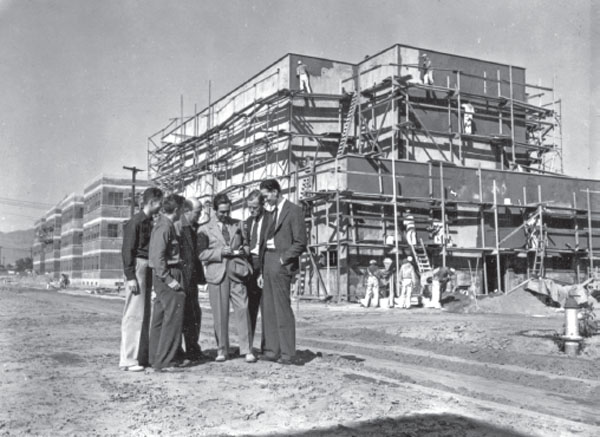
Walt Disney (center) visits the construction site of his new studio in Burbank, 1939. Burbank Historical Society .
The studio has always played a part in the Burbank community, and Disney artists have lent their talents to various city functions and institutions. In fact, during the 2011 centennial celebrations at city hall, Mickey and Minnie Mouse served as Disney representatives.
We return to Richard Dixon’s childhood memories, this time of the Disney lot in the 1940s, for some wonderful lore:
Sometimes, in the summer, when we weren’t cooling off at Pickwick Swim Park we would cross Olive Avenue and walk over to the back of the Walt Disney Studios lot, which was only five blocks away, and swim in the amazingly crystal clear pond which was created from the water runoff from Disney’s cooling system. In those days air conditioning was not yet available. Disney had installed water sprinklers on top of all the offices and sound stages, which cooled them. This water runoff was then piped out the back of the studio and into a large pit which formed a perfect swimming pond of crystal clear water at the edge of the L.A. River, which had only dirt banks back then .
Next to the pond was a huge burn pile where the studio burned all the thrown away film clippings, sketches and cells from the animation department. I have always wished I had collected these drawings that were lying all over the place, as they would be worth a fortune now .
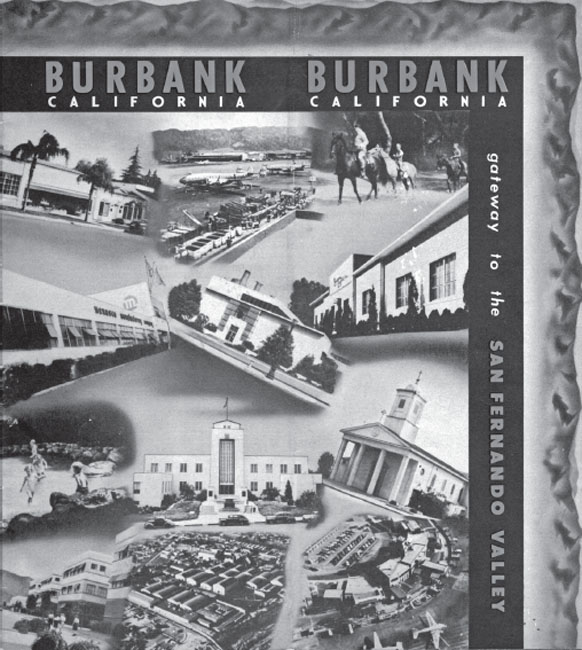
Burbank booklet given to new employees by Walt Disney Studios in 1947. Collection of Michael B. McDaniel .
When the Disney Company looked for talent, it looked locally. Kathryn Beaumont, the ten-year-old model for Alice in Wonderland (1951), was later a Burbank High School student (class of 1955).
As a matter of interest, Walt Disney died on December 15, 1966, in the St. Joseph’s Hospital in Burbank. When he died, his Burbank office was sealed, but you can see it preserved at Disneyland, down to the paperwork left on his desk.
COLOR CITY
The first purpose-built color television studio in the United States was erected by RCA, the parent company of the National Broadcasting Corporation (NBC), in March 1955 on West Alameda Avenue. It was nicknamed “NBC Color City” and occupied forty-nine acres of land (thirty of it purchased from Jack Warner).
Burbanker Jimmy Koren has a funny story about this facility:
My first pair of cowboy boots is buried under the NBC building! I was ten years old when they were building that place, and we were playing shoeless in the piles of sand. Lo and behold along comes a tractor to start pushing the sand around.…Goodbye boots! Imagine getting home and ’splaining to Mom why you’re barefooted .
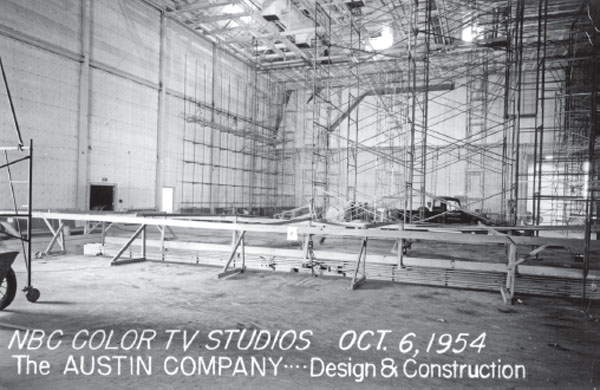
A progress postcard showing the construction of the NBC Studios on West Alameda Avenue, 1954. One gets a good idea of the interior volume of a television sound stage from this image. Collection of Michael B. McDaniel .
ROWAN AND MARTIN ’S LAUGH -IN
The entire run of the show was filmed at the NBC Studios, and as noted in just about any work about Burbank, the phrase “beautiful downtown Burbank” was first coined on the show by Gary Owens, who served as the announcer. It was a funny moment when, at the ceremony for the 100th anniversary of the city’s incorporation, held in front of city hall, Owens once again cupped hand over ear in his characteristic fashion and uttered the famous catchphrase, to wild cheers.
The show almost always opened with some reference to Burbank, including the following examples: “From the lovely Coconut Room high atop the Unemployment Building in beautiful downtown Burbank, it’s Rowan and Martin’s Laugh-In !”; “From the recovery room of the beautiful Uptown Hospital here in beautiful downtown Burbank, it’s Rowan and Martin’s Laugh-In !”; “Coming to you from the beautiful downtown Burbank Bird Sanctuary and Rifle Range, it’s Rowan and Martin’s Laugh-In !”; “From the steam room of the beautiful downtown Burbank Post Office and Maternity Ward, it’s Rowan and Martin’s Laugh-In !”; and “From the beautiful downtown Burbank Municipal Court House and Topless Bowling Alley, it’s Rowan and Martin’s Laugh-In !” There were many more.
A Los Angeles Times article from May 16, 1968, notes that the Burbank City Council, knowing a good publicity angle when it saw one, voted unanimously to invite Dan Rowan and Dick Martin to ride on the city’s Tournament of Roses float that year. “Beautiful downtown Burbank” soon caught on and put Burbank on the map with television viewers all across the country. It wasn’t long before postcards began to be printed with the phrase, allowing visitors to document to folks back home whether or not they had found the place beautiful. The city also became the butt of jokes on Rowan and Martin’s Laugh-In ; one memorable spot featured Eve Arden commemorating Burbank’s many famous and historic vacant lots. 20
The joke, of course, is that beauty is in the eye of the beholder. While there are many who insist that Burbank is indeed beautiful, others, like Frank Zappa, have claimed that the San Fernando Valley is the ugliest and most charmless place in the country. 21 Whether that is the case, you, Gentle Reader, may decide.
It is worth noting that the phrase “beautiful downtown Burbank” was, for a time, a registered trademark owned by the Burbank Chamber of Commerce. The trademark is now dead—additional comedic fodder for those who wax cynical about Burbank.
THE TONIGHT SHOW STARRING JOHNNY CARSON
From 1972 to 1992, announcer Ed McMahon began each broadcast of The Tonight Show Starring Johnny Carson with a bald-faced lie that caused Burbankers’ jaws to clench: “From Hollywood.” No, no, no…it was broadcast from the NBC Studios in Burbank. The show moved there from New York City on May 1, 1972.
In 1979 Dan Remy, a city councilman, claimed, “Burbank is the current Hollywood. Hollywood is simply a name.” As true as that may have been, it didn’t stop Carson from constantly ribbing Burbank in monologues: “Burbank leads the nation in the number of squirrel suicides.” “Burbank was founded by Dr. David Burbank, a dentist—apparently he thought it was a great place to have a toothache.” “Burbank has an official flag—a deceased crow.” “Burbank has a nightclub for senior citizens: the Slipped Disco—if you put your drink down somebody will put his teeth into it.” “You can kill a weekend in Burbank by taking the Forest Lawn Tour.” 22 “On New Year’s Eve in Burbank everyone gathers around and watches the mayor drop a Ring Ding from the roof of a 7-Eleven.” “Burbank’s favorite Italian restaurant is Vinnie Abruzzi’s Little Touch of Newark—a table with a view is near the ladies room with the door opened.” And there were many others.

Johnny Carson looms over Burbank in this whimsical 1981 poster welcoming visitors. Courtesy of Carson Entertainment Group. Jack Paul Miller, artist .
Burbank, unfazed, made Johnny Carson an official Burbank Ambassador (with all the rights and privileges thereunto pertaining), and in 1981, there appeared a “Beautiful Downtown Burbank” poster featuring Carson looming over the Verdugo Hills. In 1992 Burbank renamed Buena Vista Park, across the street from the NBC Studios, as Johnny Carson Park.
THE BURBANK STUDIOS
What’s “lost” about this site? It’s no longer owned by NBC. Universal Studios merged with NBC in 2003 to form the current NBCUniversal. This being the case, Universal moved its television operations to a newer and larger studio a few miles away (the Tonight Show moved back to New York City), and by 2008, NBC had sold the facility. It is now known, generically, as the Burbank Studios. Currently, only the daytime soap opera Days of Our Lives is produced there—a far cry from its busy earlier history.
THE PATSY AWARDS
You’ve heard of the Oscar, Emmy and Tony Awards. Have you ever heard of the Patsy Award? The award’s Wikipedia page states:
The Patsy Award was originated by the Hollywood office of the American Humane Association in 1939. They decided to honor animal performers after a horse was killed in an on-set accident during the filming of the Tyrone Power film Jesse James. The letters are an acronym, and stand for Picture Animal Top Star of the Year .
The very first recipient of a Patsy was Francis the Talking Mule in 1951. The award now covers both film and television and is separated into four categories: canine, equine, wild and special. The special category encompasses everything from goats to cats to pigs—Arnold Ziffel of TV’s Green Acres was a two-time winner. Arnold’s trainer, Frank Inn, was the proud owner of over 40 Patsy awards, thanks to his work with Orangey, the cat from Rhubarb (1951) and Breakfast at Tiffany’s (1961); Higgins, the dog (who played the lead in the Benji movies and “Dog” on Petticoat Junction); Cleo the Basset Hound; and Lassie, to name a few. Bob Barker served as host for the Patsy Awards but eventually resigned in protest of the cruel methods some trainers use when training animals for films. The awards ended in 1986 due to lack of funding .
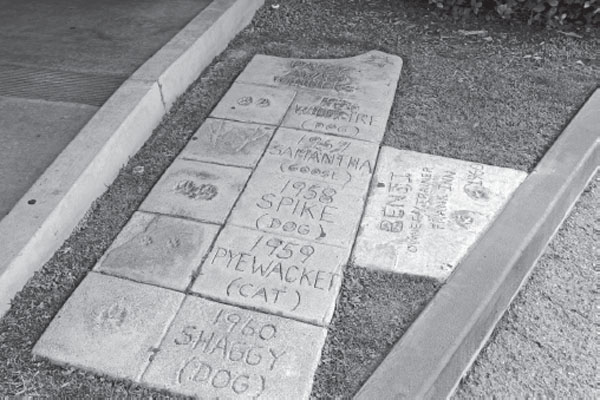
Some of the various Patsy Award winners’ paw prints enshrined at the Burbank Animal Shelter. Wes Clark .
The movie award recipients from 1951 to 1960 have their names and paw prints in the courtyard of the Burbank Animal Shelter at 1150 North Victory Place. The shelter used to be located under the Burbank Boulevard overpass at the Five Points; when the shelter was moved, so were the paw prints.
BORING PORN , UNEXPECTED PORN…AND TOILET PAPER
Given all the film industry labs in town and the fact that the San Fernando Valley of California is the pornography capital of the United States, 23 it stands to reason that Burbank probably has some entertaining porn industry stories. And so it does. There is a bizarre July 10, 1977 Los Angeles Times article about the owners of the Allied Color Laboratories in Burbank playing tricks on one another. One such trick involved toilet paper—six hundred rolls of it—wound around a home on Elmwood Avenue, entirely obscuring it from view. What caused this outsized retaliation was the filling of one of the tricksters’ 1977 Porsche with pornographic films (such films being a product of the Allied Color Labs) and an exterior plastered with “the lewdest, most horrible photographs we could find.” The neighbors had mixed reactions. One, a resident since 1940, called it “the greatest thing to ever happen” (it topped Lockheed in World War II?). Another called in the Burbank fire and police departments as well as the city zoning folks. Burbank officials demanded that the toilet paper be entirely removed by nightfall. The victim was recorded as stating, “I’ll get my revenge. We have to do something to break the monotony of this work.” So there you have it: processing pornography is boring . Who knew?
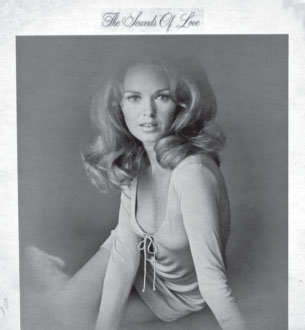
The 101 Strings: The Sounds of Love . Not a Grammy winner. Wes Clark Collection .
Admittedly, the next Burbank porn tale is pretty lightweight and involves the otherwise staid 101 Strings, a musical ensemble famed for recording vinyl albums of the “easy listening” genre with such titles as The Emotion of 101 Strings at Gypsy Campfires, 101 Strings Play the Sugar & Spice of Rudolph Friml, 101 Strings Plays Hit Songs for Girls and Million Seller Hits of 1966 . These budget discs usually went for $1.99 each and could be found in grocery store record bins all across America. While the recordings were produced in Germany (the 101 String Orchestra was, in fact, the Orchester des Nordwestdeutschen Rundfunks Hamburg), the vinyl was pressed in Burbank by A/S Records (Alshire Records). Enthusiastic buyers of these albums skewed toward the sixty-five-and-over demographic. It was especially odd, then, when the group released its most infamous record: 101 Strings: The Sounds of Love . Meaning, literally, the sounds of love as gasped and moaned by one Bebe Bardon, female vocalist. The authors tried listening to The Sounds of Love one night. It’s pretty horrible. Cascading strings mixed with porn vocals just doesn’t make for a meaningful musical experience. (Hear for yourself. Some of these cuts are on YouTube.) Sometimes, “lost” is not a bad thing.
Finally, there was the time in October 1994 when surprised Burbank Water and Power employees arrived at work to find that the area was the site of the filming of a pornographic movie. The police department clerk, when approving a request for what she thought was an ordinary film, granted the permit. (Burbank grants filming permits for 175 to 200 productions each year.) Among the memorable quotes from interested parties are the following: “That’s not the type of image we want for the city.” (Ron Stassi, general manager of the Public Services Department.) “We never, ever, ever, ever, ever—and I will say that double emphatically—shoot [X-rated movies] without having permission, without being up front about it.” (Nick Pinkowski, porn movie producer.) “I guess they got to film it somewhere, but it’s different than if you spend $20 on a nudie bar and are pretty well liquored up and don’t care what’s going to happen. It’s different than coming stone sober to work. It shouldn’t occur in the workplace.” (Surprised BWP employee.)
FALCON THEATRE
Most Burbankers are aware that the Falcon Theatre, located on 4252 West Riverside Drive, was founded and owned by famous producer Garry Marshall. Befitting a man who may be regarded as an elder statesman of entertainment, it’s a venue that specializes in new work by emerging artists. But why is it called the Falcon Theatre?
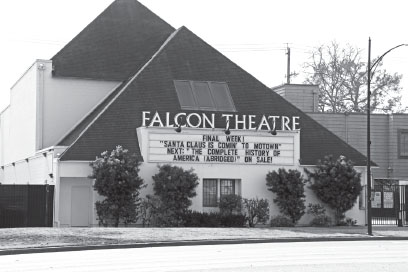
Garry Marshall’s Falcon Theatre on 4252 West Riverside Drive. Wes Clark .
As a teen, Marshall was familiar with the gang scene in the Bronx, where he grew up. (In fact, the character of Arthur “The Fonz” Fonzarelli on Happy Days was based on an especially charismatic youth he knew named Pete Wagner.) It’s simple: The Falcons was the name of Marshall’s gang; it was a 1950s Bronx street gang that morphed into a sports club when the boys grew tired of getting beaten up.
FAMOUS BURBANKERS IN THE ENTERTAINMENT INDUSTRY
Wikipedia and notes kept by the Burbank Historical Society give a list of notable Burbankers from all career fields. The ones you might know from the entertainment industry are noted here, in no special order:
Debbie Reynolds, Jane Russell, Ann Sheridan, Roy Rogers, Johnny Grant, Peggy Ryan, George Putnam, Glenn Strange, Frankie Laine, Angie Dickinson, Vic Tayback, Don Grady (Agradi), Gary Grimes, Dan Haggerty, Jennifer Love Hewitt, Rene Russo, Angela Cartwright, Anson Williams, Sterling Beaumon, Juice Newton, Eddie Rabbitt, Kim Fields, Tyler Blackburn, Kelly Blatz, Tim Burton, Debbe Dunning, Masiela Lusha, Mark Harmon, Ron Howard, Clint Howard, Kristy McNichol, Erin Moran, Elijah Wood, Mitch Vogel, Blake Lively, Chris Marquette, Cady McClain, Hayley McFarland, Eve Plumb, Jason Ritter, John Ritter, Wil Wheaton, and Anton Yelchin .
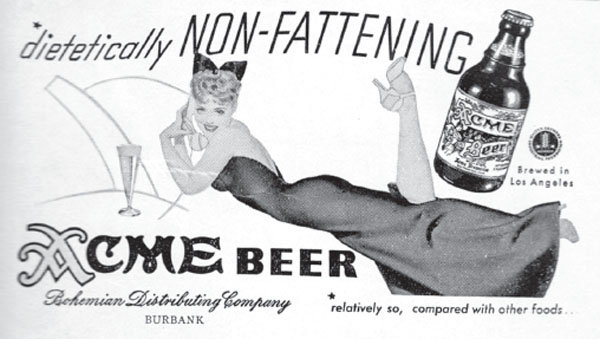
Only in Burbank could beer be (relatively) nonfattening. Collection of Michael B. McDaniel .
There are undoubtedly others, but we shall rely on the constantly updated Internet for those.